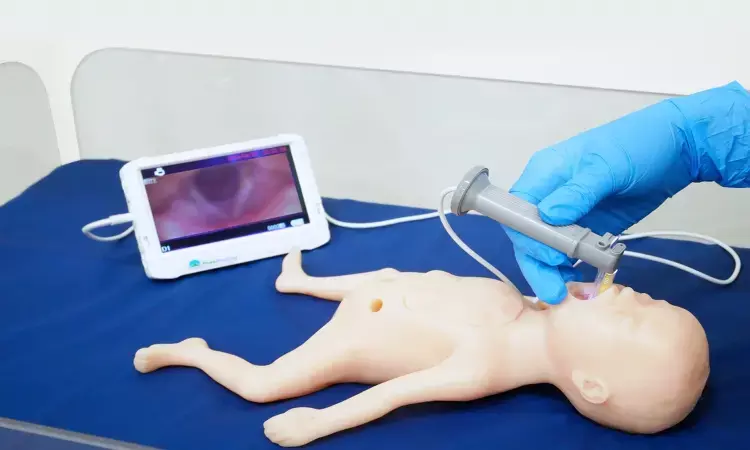- Home
- Medical news & Guidelines
- Anesthesiology
- Cardiology and CTVS
- Critical Care
- Dentistry
- Dermatology
- Diabetes and Endocrinology
- ENT
- Gastroenterology
- Medicine
- Nephrology
- Neurology
- Obstretics-Gynaecology
- Oncology
- Ophthalmology
- Orthopaedics
- Pediatrics-Neonatology
- Psychiatry
- Pulmonology
- Radiology
- Surgery
- Urology
- Laboratory Medicine
- Diet
- Nursing
- Paramedical
- Physiotherapy
- Health news
- Fact Check
- Bone Health Fact Check
- Brain Health Fact Check
- Cancer Related Fact Check
- Child Care Fact Check
- Dental and oral health fact check
- Diabetes and metabolic health fact check
- Diet and Nutrition Fact Check
- Eye and ENT Care Fact Check
- Fitness fact check
- Gut health fact check
- Heart health fact check
- Kidney health fact check
- Medical education fact check
- Men's health fact check
- Respiratory fact check
- Skin and hair care fact check
- Vaccine and Immunization fact check
- Women's health fact check
- AYUSH
- State News
- Andaman and Nicobar Islands
- Andhra Pradesh
- Arunachal Pradesh
- Assam
- Bihar
- Chandigarh
- Chattisgarh
- Dadra and Nagar Haveli
- Daman and Diu
- Delhi
- Goa
- Gujarat
- Haryana
- Himachal Pradesh
- Jammu & Kashmir
- Jharkhand
- Karnataka
- Kerala
- Ladakh
- Lakshadweep
- Madhya Pradesh
- Maharashtra
- Manipur
- Meghalaya
- Mizoram
- Nagaland
- Odisha
- Puducherry
- Punjab
- Rajasthan
- Sikkim
- Tamil Nadu
- Telangana
- Tripura
- Uttar Pradesh
- Uttrakhand
- West Bengal
- Medical Education
- Industry
Airway Mastery: Insights from First-Pass Videolaryngoscopic Intubation Trials

Recent prospective observational study conducted on 224 adult patients undergoing elective videolaryngoscopic intubations with a Macintosh blade evaluated the first-pass success rate of intubations performed without a stylet. Eligible patients were rigorously selected, and various medical conditions were considered exclusion criteria to ensure a comprehensive analysis. The results revealed an impressive first-pass success rate of 80%, that increased to 96% for second attempts involving laryngeal manipulation. Only 4% of patients required a stylet, indicating that routine stylet usage may be unnecessary for most elective cases using this technique.
Factors Influencing Success
Factors impacting first-pass success included conventional airway assessment metrics such as the Mallampati score, Cormack-Lehane grade, thyromental and sternomental distances, and cervical spine mobility. Additionally, ultrasonographic evaluations showed that patients achieving first-pass success typically exhibited reduced tongue thickness and a shorter skin-to-epiglottis distance. These findings emphasize the significance of pre-intubation assessments in predicting airway management difficulty.
Predictive Factors Analysis
Multivariable logistic regression models established several predictive factors for successful intubation without a stylet. Longer sternomental distances and increased thyromental height positively correlated with success. In contrast, restricted cervical spine mobility demonstrated a negative association with first-pass success. The original logistic regression model yielded an area under the curve (AUC) of 0.83, indicating good predictive capability, while an extended model incorporating additional ultrasonographic parameters showed a slight improvement (AUC 0.84). Notably, the analysis underscored the clinical importance of using laryngeal manipulation in enhancing first-pass success rates and demonstrated that although a stylet may be beneficial in specific adverse scenarios, its necessity is infrequent. The minor incidence of postoperative complications, including throat soreness and hoarseness, was also documented, with a significant correlation between stylet use and postoperative hoarseness. Despite the high first-pass success rate observed, limitations present included restricted patient demographics, the use of a single type of videolaryngoscope, and the generalizability of findings to broader populations, particularly in cases with a higher body mass index or previous cervical spine surgeries. Future research directions recommend evaluating the predictive factors across diverse populations and refining clinical models that inform stylet necessity, maintaining a crucial balance between successful intubation and minimizing potential complications.
Key Points
- A prospective observational study with 224 adult patients undergoing elective videolaryngoscopic intubations using a Macintosh blade was conducted to assess the first-pass success rate without a stylet, achieving an 80% success rate that increased to 96% with laryngeal manipulation on second attempts, suggesting a low necessity for routine stylet use in these scenarios.
- Key factors influencing first-pass success were identified through conventional airway assessment metrics including Mallampati score, Cormack-Lehane grade, thyromental and sternomental distances, as well as cervical spine mobility, highlighting the importance of thorough pre-intubation assessments.
- Ultrasonographic evaluations indicated that successful first-pass intubations were correlated with decreased tongue thickness and reduced skin-to-epiglottis distance, providing additional criteria for predicting airway management challenges.
- Multivariable logistic regression analysis identified longer sternomental distances and increased thyromental height as positive predictors of successful intubation without a stylet, while restricted cervical spine mobility emerged as a negative predictor, with the original logistic regression model showing a good predictive capability (AUC 0.83) and an improved model including ultrasonographic metrics yielding an AUC of 0.84.
- The importance of laryngeal manipulation in enhancing first-pass success rates was emphasized, suggesting that while a stylet may be advantageous in select adverse scenarios, its routine use is infrequent in elective intubations.
- Limitations of the study include a singular patient demographic focus, reliance on one type of videolaryngoscope, and concerns regarding the generalizability of results to populations with higher body mass indices or those with prior cervical spine surgeries, which calls for further research into predictive factors across diverse populations and refining models for stylet necessity.
Reference –
Song, S.E., Jung, JY., Jung, CW. et al. First-pass success rate and predictive factors for stylet use in videolaryngoscopic intubations with a Macintosh blade: a prospective observational study. Can J Anesth/J Can Anesth 72, 758–767 (2025). https://doi.org/10.1007/s12630-025-02952-0
MBBS, MD (Anaesthesiology), FNB (Cardiac Anaesthesiology)
Dr Monish Raut is a practicing Cardiac Anesthesiologist. He completed his MBBS at Government Medical College, Nagpur, and pursued his MD in Anesthesiology at BJ Medical College, Pune. Further specializing in Cardiac Anesthesiology, Dr Raut earned his FNB in Cardiac Anesthesiology from Sir Ganga Ram Hospital, Delhi.


